| Dateline: Apia,
Western Samoa, 0630 Local Time, 6 August 2007 |
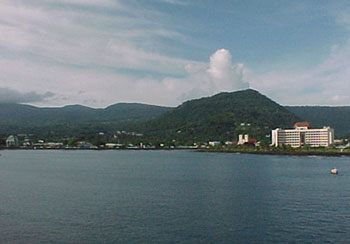 Surrounded by land! an odd feeling after weeks of
sea and sky. The Samoan Islands are volcanic, with real elevation, running
water, and everything. They arrived about midnight and now await the business
day and Customs. The flight for Fiji leaves at 2 a.m., leaving plenty of
time to pack and ship all the gear that is returning to the States. Surrounded by land! an odd feeling after weeks of
sea and sky. The Samoan Islands are volcanic, with real elevation, running
water, and everything. They arrived about midnight and now await the business
day and Customs. The flight for Fiji leaves at 2 a.m., leaving plenty of
time to pack and ship all the gear that is returning to the States.
Ric is hand carrying the most important artifacts:
- The pull and slide of a zipper.
- A snap of the kind used on clothing – both sides.
- A small piece of flat mirror, such as that found in a compact.
- Remnants of a pocket knife.
- Brown and green bottle glass.
- The bronze bearings.
The Seven Site returned very interesting results, with the outline of
a story appearing in the burn features, fish, bird and turtle remains,
clothing remains. A castaway lived here, ate here – died here? Did this
person die wearing the clothing, which has now disintegrated completely
aside from the metal pieces? Did Gallagher fail to find clothing because
it was already gone, rotted away?
The zipper is fairly small and is not rusted. It is very plain, with a
rectangular pull bearing the name of the manufacturer. On the reverse of
the pull Ric thinks he can make out some numbers. This will be the first
order of business, obviously, to identify this item.
In a unit slightly outside of the cleared area they found a small medicine
bottle with a patent number. One of the team, Bill Carter, is a lawyer
with a great deal of experience in patents. He called the U.S. Patent Office
and found out the number is assigned to the bottle design, and was issued
in 1895.
The team will fly from Fiji on the night of the 9th, arriving
in Los Angeles the 9th, having crossed the Date Line for the
fourth time this trip. From there they disperse to homes, families, jobs,
and Real Life.
All in all, a very successful trip. We’ll be posting photographs and video
clips as soon as possible, I hope by Saturday or Sunday for some stills
at least. There are thousands of photos and hours of video to sort through,
but we’ll get it on the website as soon as we can.
Thanks to everyone for your support.

|
| Dateline: Nikumaroro,
0930 Local Time, 2 August 2007 |
The final day. The Seven Site is closed and covered.
The last day of work there revealed yet more M-1 rounds, and also some more
metal clothing fasteners. There will be a lot of research to do to firmly
identify these items in the next few weeks. The island has been swept almost
clean by Time, using the tools of wind and water. All that remains is the
bits and pieces, traces and faint tracks, of the lives that were lived there,
however briefly.
Yesterday John, Josh, and Ric spent the day collecting the tide data on
the reef-flat which ties together the tide tables for the channel, the flat
out by Norwich City, and the base-line data using current tables for
Hull (Orona) Island. All the data are now
being entered into the laptop for crunching before the seas kick up again
and make keyboarding impossible. The total stations are back aboard, packed
safely away in their cases, un-dunked and undamaged. At low tide the reef
flat is drying completely; this is a cycle, the period of which we do not
yet know.
The boat is out of the lagoon, and the team is spending the last day “wildcatting”
with metal detectors in and around the village – just in case. Tom
Roberts talked one of the Nai’a crew into walking completely
around the island with him. Others have done this, but most of the gang think
he’s nuts. See the Bevington
Diary for a description of an earlier tour.
They expect to get underway before sunset, heading for Apia and a flight
back to Fiji on the 7th. They fly out of Fiji at 10 p.m. on the 9th.
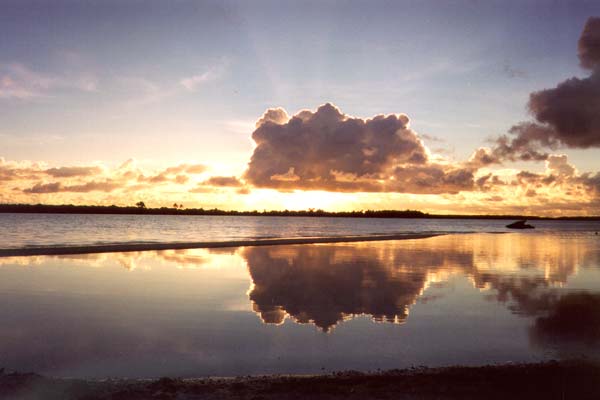
Sunset at Nikumaroro. Photo by John Clauss.
|
| Dateline: Nikumaroro,
1430 Local Time, 1 August 2007 |
Ric was aboard half the day, scanning through hundreds
of frames of photographs from the kite photography, which is a spectacular
success. The idea is to find things to go look at now, while they are still
there, rather than three weeks from now when we’d have to mount another expedition.
There is stuff back in the bush that is totally invisible on the ground from
three feet away – but breaks in the foliage make it possible to see from
the air.
The tides have cycled through so that they are coming off the island at
dead low tide now. This is hairy. One must jump down into the skiff from
the coral ledge. The skiff, of course, is moving. There is a tendency to
go splat in the bottom of the skiff unless the incredibly strong and well-balanced
and co-ordinated Fijian crew can catch you. This is a Good Thing because
going splat hurts. The reef flat is dry well past dead low tide.
 |
This is a black-tip reef shark – a
young one in the extreme shallows of the lagoon. They grow to some
four or five feet in length. |
Ric spent the morning metal detecting in the area of the lagoon that received
the overwash from the storm which cleared out everything from the radio shack
and beyond (see photo below for July 31). There was only one small hit, which
may be interesting. But what was really interesting was the company he had:
a shark he’s named Nicodemus after the pursuing shark in Treasure Island.
About four feet long, Nick is a black tip reef shark, and usually they are
pretty harmless. But this one seems bent on giving anyone he sees the willies.
We think he’s the same shark that treed Bill Carter on a coral head last
trip. Ric bopped him in the nose with the metal detector and that discouraged
him some, but he was still lurking around, singing the shark theme from Jaws,
every time Ric looked over his shoulder.
One very interesting find at the Seven Site: the pull to a metal zipper,
made by a company that has been around a long time. I’ve got an inquiry in
to them; results will depend on how good their historical records are.
One of the photographs from the kite may be an object that Jeff Glickman
of Photek spotted in the 1939 photograph. Film at 11.
More brown glass, burned and unburned, has also been found. Many more bones
in yet another fire unit. The picture here is of continuous use over time,
not a single “camping” expedition or picnic.
Today was the last full day of work at the Seven Site. The boat must come
out of the lagoon tomorrow morning at high tide, and by tomorrow evening
they expect to be under way for Apia.
|
| Dateline: Nikumaroro, 1700 Local Time, 31 July 2007 |
Three full days of work left, then a break-down
day and off to Apia.
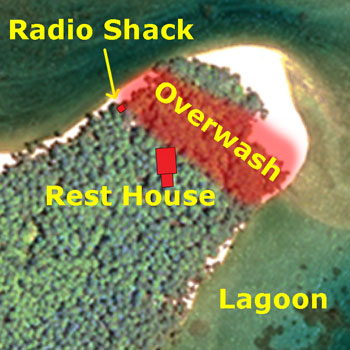 Metal
detecting in the village continues, with lots of little stuff found, pieces
of things scattered downstream by a storm overwash. Sometime between 2003
and now enough sea came ashore to cover the north end of the village site
two to three feet deep and clear out all light debris. There are no deep
deposits of coconuts, no piles of fronds more than a year or so’s accumulation.
The overwash would have carried off light metal debris as well, and left
behind things that are small but dense – like bronze sleeve bearings. Anything
taken by the storm is in the lagoon somewhere. Metal
detecting in the village continues, with lots of little stuff found, pieces
of things scattered downstream by a storm overwash. Sometime between 2003
and now enough sea came ashore to cover the north end of the village site
two to three feet deep and clear out all light debris. There are no deep
deposits of coconuts, no piles of fronds more than a year or so’s accumulation.
The overwash would have carried off light metal debris as well, and left
behind things that are small but dense – like bronze sleeve bearings. Anything
taken by the storm is in the lagoon somewhere.
The kite aerial photography is very successful and spectacular results have
been obtained. Something visible in multiple shots is a feature they are
calling the “doughnut” – a dark round area just outside of the cleared site
(of course). They’ll look at it today and see what it is.
The Official Party was held last night, rather than on the
last night at the island. The boat’s crew had a lovo going all day – an earth
oven – and an evening of music, kava, and merriment was planned. The sea
has backed down a bit so they shouldn’t be so tossed about.
It’s been a hard trip, and drives home the simple message of Nikumaroro:
like the sea and the sky, the island is utterly indifferent to humans and
their plans. It won’t try to kill you – at least not deliberately – but it
won’t cut you any breaks, either. All you can really do is keep your sword
bright and your intention true, and your head screwed on tight. The least
inattention can cause disaster.
|
| Dateline:
Nikumaroro, 1700 Local Time, 30 July 2007 |
The team meeting on the 29th focused on allocation
of assets for the remaining days of active work. As always, there is far
more to do than the available person-hours can accomplish. The work at the
Seven Site is particularly greedy, but understanding the castaway’s environment
and actions is extremely important.
The village is almost done. Three more sleeve bearings have been found,
and some smaller bearings and bushings which have no part numbers. If the
parts are pre-World War II, this isn’t surprising; it was during the great
build-up of manufacturing during the war that the custom of putting a number
on each individual part, however small, grew up, to meet the needs of a lesser
trained work force.
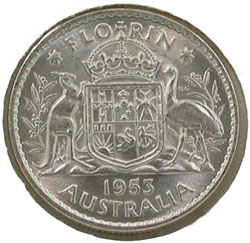 |
This is an Australian Florin. |
Also found:
- Compression fittings for hydraulic lines (?)
- Very high quality stainless steel wire cable, originally seven strands,
with one or two strands removed (probably for local use)
- Another knob, but this one is intact.
- Sheet aluminum, not Alclad, cut up
- A 1953 Australian florin
The
Village produces Stuff – items gathered and stockpiled, used and re-used, cut
up and shaped. The Seven Site produces bird bones, fish bones, burn features,
and – just possibly, if we are lucky and thorough – some human remains. The
priority there continues to be raking, scanning, excavation, and screening. They are still tied off to the Norwich City, but must cast off at night
and steam out to sea to avoid being tossed onto the reef. No one particularly
wants to be the next Castaway of Gardner Island.
|
| Dateline:
Nikumaroro, 1700 Local Time, 29 July 2007 |
The sea is causing real problems now. They’ve had to move the boat
off the anchorage because it was taking 50° rolls and putting the gunwales
under water. They are now tied off to the last bits of wreckage of the Norwich
City, which works well as long as the wind, current, and swell stay the
same. If not, then they must stay under way, standing on and off the island,
during the day, and head out to sea at night. As a result of the rough
water folks aren’t sleeping too well, which makes them accident prone.
So far no major problems but everyone is on high alert. The landing channel
can be especially tricky with cross-currents and rips colliding to form spectacular
seas.
At the Seven Site work has continued on a new unit with a lot of burned
fish and bird bones; obviously a meal site. More brass from ammunition has
been found, including .22 rounds (Gallagher had a .22). A brass ring-shaped
object has come to light as well; not a machined part, more like something
off the end of a small pipe, approximately ½ inch in diameter with
an interior diameter of perhaps ¼ or slightly more.
In the village Gary reported “good aluminum” but Ric did not have details
yet when he called me. There is a bit of “tit for tat” going on with this;
there appears to be some rivalry between the two teams and a good-natured
effort to one-up each other. All is revealed at the team meeting each night.
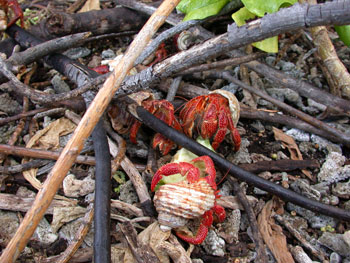 The crabs have gone off with the bones. Attempts to track them have been
unsuccessful so far; apparently they are going quite a bit farther than anyone
thought, so the search will have to be expanded. The crabs have gone off with the bones. Attempts to track them have been
unsuccessful so far; apparently they are going quite a bit farther than anyone
thought, so the search will have to be expanded.
The crabs and rats at the Seven Site have grown quite bold with exposure
to humans. The strawberry hermit crabs now attempt to climb the legs
of anyone standing still, and the rats will plop themselves on the log next
to someone eating lunch and ask for a share in the sandwich. The rats also
mug the crabs for anything the crabs have scavenged. Funny in this context
… but I don’t think it would be such a great place to be stranded.
Strawberry hermit crabs foraging in 2001. They are about
the size of a baseball, including shell.
|
|

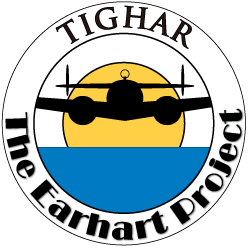

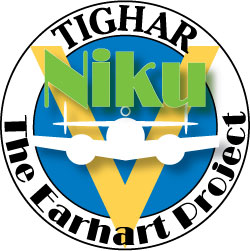
 Surrounded by land! an odd feeling after weeks of
sea and sky. The Samoan Islands are volcanic, with real elevation, running
water, and everything. They arrived about midnight and now await the business
day and Customs. The flight for Fiji leaves at 2 a.m., leaving plenty of
time to pack and ship all the gear that is returning to the States.
Surrounded by land! an odd feeling after weeks of
sea and sky. The Samoan Islands are volcanic, with real elevation, running
water, and everything. They arrived about midnight and now await the business
day and Customs. The flight for Fiji leaves at 2 a.m., leaving plenty of
time to pack and ship all the gear that is returning to the States.

 Metal
detecting in the village continues, with lots of little stuff found, pieces
of things scattered downstream by a storm overwash. Sometime between 2003
and now enough sea came ashore to cover the north end of the village site
two to three feet deep and clear out all light debris. There are no deep
deposits of coconuts, no piles of fronds more than a year or so’s accumulation.
The overwash would have carried off light metal debris as well, and left
behind things that are small but dense – like bronze sleeve bearings. Anything
taken by the storm is in the lagoon somewhere.
Metal
detecting in the village continues, with lots of little stuff found, pieces
of things scattered downstream by a storm overwash. Sometime between 2003
and now enough sea came ashore to cover the north end of the village site
two to three feet deep and clear out all light debris. There are no deep
deposits of coconuts, no piles of fronds more than a year or so’s accumulation.
The overwash would have carried off light metal debris as well, and left
behind things that are small but dense – like bronze sleeve bearings. Anything
taken by the storm is in the lagoon somewhere.
 The crabs have gone off with the bones. Attempts to track them have been
unsuccessful so far; apparently they are going quite a bit farther than anyone
thought, so the search will have to be expanded.
The crabs have gone off with the bones. Attempts to track them have been
unsuccessful so far; apparently they are going quite a bit farther than anyone
thought, so the search will have to be expanded.